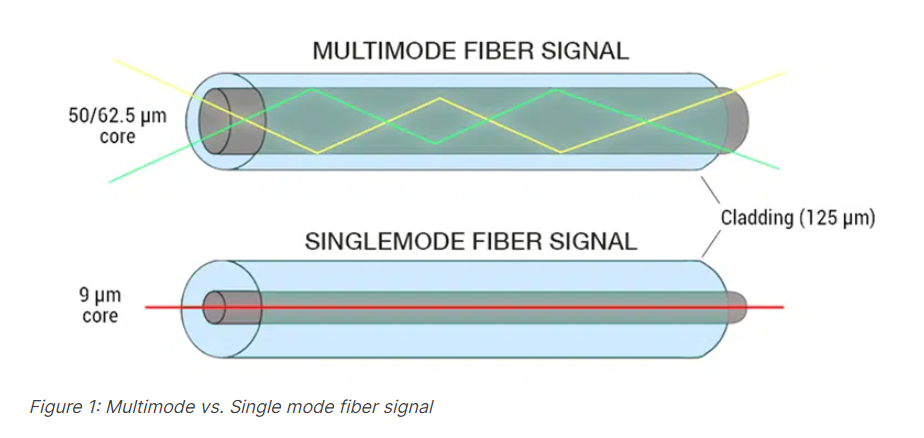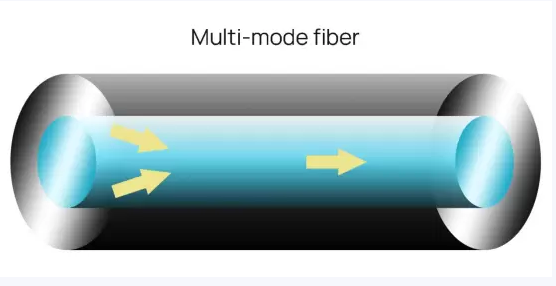

 Knowledge Base +
Knowledge Base +  2024.01.18
2024.01.18A “mode” is a beam of light that enters the fiber at a specific angular speed. Multi-mode fiber allows multiple beams of light to propagate simultaneously in the fiber, resulting in mode dispersion (because each “mode” of light enters the fiber at a different angle, they arrive at the other end at different times, a feature called mode dispersion.) The mode dispersion technique limits the bandwidth and distance of multi-mode fiber, resulting in a thick core, low transmission speed, short transmission distance, and poor overall transmission performance.
However, multi-mode fiber has the advantage of relatively low cost and is commonly used in buildings or geographically adjacent environments. Single-mode fiber only allows one beam of light to propagate, so it does not exhibit mode dispersion characteristics. As a result, single-mode fiber features a correspondingly thin core, wide transmission bandwidth, high capacity, and long transmission distance, but it is more expensive due to the requirement of a laser source.
Single mode fiber, short as SMF, is the fiber cable that only allows one mode of light to transmit. Typically, this fiber includes a small light-carrying core of about 9µm diameter. These feature a small modal dispersion for vast-distance signal transmission.
Read More What is the difference between a single mode SFP and a multimode SFP Beginners Guide
In contrast with multimode fiber, single mode enables the concentration of light to go quicker and farther. That is crucial for high-speed networks over a long distance.

Unlike single mode, multimode fiber (MMF) allows multiple light modes to transmit and pass through. Typically, this fiber includes a large light-carrying core of about 50µm or 62.5µm diameter. That makes manufacturing easier and offers a lower cost ratio on the same length.

However, due to modal dispersion, this limits the most significant length of transmission connections. So, these fibers are mainly for the short-distance transmission of signals.
Commonly, multimode fiber can be divided into five types:
OM1: it has a diameter of 62.5µm and an orange jacket. With 200/500 MHz*km overfilled launch (OFL) bandwidth at 850/1300nm, it is suitable for 100 Megabit and 1G Ethernet applications.
OM2: it has a diameter of 50µm and an orange jacket. With 200/500 MHz*km overfilled launch (OFL) bandwidth at 850/1300nm, it is suitable for 100 Megabit, 1G, and 10G Ethernet applications.
OM3: The laser-optimized MMF fiber supports 2000 MHz*km effective modal bandwidth. With a diameter of 50µm and an aqua jacket.
OM4: A further laser-optimized fiber supports 4700 MHz*km EMB bandwidth. Sutitable for 10 Gb/s, 40 Gb/s, and 100 Gb/s transmissions.
OM5: also known as WBMMF (wideband multimode fiber), uses two fibers to transfer data at speeds ranging from 40 GB/s, 100 GB/s to 400 GB/s.
When comparing how singlemode and multimode fiber are manufactured, there’s one big differentiator: Singlemode fiber’s core size is smaller and carries light directly down the fiber (it only allows the fundamental mode of light to transmit down the fiber). As a result, light reflection created during light transmission decreases, lowering attenuation and allowing the signal to successfully travel over longer distances.
Read More Can I connect multimode SFP to single mode fiber
Multimode’s core size is five to six times larger in diameter than singlemode, which allows for much greater light-gathering capacity and facilitates the use of cheaper electro-optic devices. Multiple modes or light paths travel down the fiber at once, which has traditionally limited transmission distance and bandwidth – but this is being considered as a modulation format for “few-mode” fiber, which we aren’t discussing here.

Because multiple modes/light paths travel down a multimode fiber cable, it only offers high bandwidth over a short distance.
When run over longer distances, modal dispersion (distortion) becomes an issue. This is typically expressed in a fiber’s “effective modal bandwidth” characteristic, which is an inverse relation between fiber bandwidth and reach distance. As signaling bandwidth increases, the reach distance decreases – and vice versa – due to the modal dispersion effect.
In singlemode fiber, all light from a pulse travels at about the same speed and arrives at roughly the same time, eliminating the effects of modal dispersion found in multimode fiber. This supports higher bandwidth levels with less signal loss over longer distances. It’s ideal for long-haul signal transmission applications, such as across or between campuses, undersea or in remote offices. There are essentially no distance limitations.
Currently, singlemode fiber is typically less expensive than multimode fiber, but it’s important to keep other price factors in mind as well.
Most fiber systems use transceivers, which combine a transmitter and receiver into a single module using fiber optic technology to send and receive data over an optical network. Right now, the price of multimode transceivers is two or three times lower than the price of singlemode transceivers.
As transceiver prices come down, however, singlemode is starting to be used more often in shorter-distance applications as a cost-effective choice.
When you see mentions of OM1, OM2, OM3, OM4 and OM5, you know you’re talking multimode fiber. But it’s not quite as simple with singlemode fiber. Today’s types of singlemode fiber include:
Standard singlemode fiber (G.652
Cutoff shifted fiber (G.654)
Low water peak fiber (G.652)
Dispersion shifted fiber (G.653)
Non-zero dispersion shifted fiber (G.655)
Bend-insensitive fiber (G.657)
Each type of singlemode fiber features its own characteristics. Depending on operating wavelengths, distance and transmission link architecture (which may include various amplification methods), there are different considerations to take into account before making a selection.
In security applications, the most common deciding factor for choosing between multi-mode or single-mode fiber is the distance. If the distance is only a few miles, multi-mode fiber is preferred. This is because LED transmitters/receivers are much cheaper than the laser needed for single-mode fiber. If the distance is exceeds 5 miles, single-mode fiber is the best choice. Another issue to consider is bandwidth. If future applications may include transmitting large bandwidth data signals, then single mode fiber would be the optimal choice.
How far can single mode fiber go?For most applications, the maximum distance of single mode cable supports around 160 kilometers. But the dispersion-compensating fibers support more than 200 kilometers of distance.
How far can multimode fiber go?
It varies with the data speed and fiber type. Take the common OM2 as an example. It supports a max of 550m at 1Gbps and 82m at 10Gbps. However, the maximum distance will be less than 2km for all multimode fibers.
What is the acceptable dB loss for single mode fiber?
According to EIA/TIA 568, the SMF loss is around 0.5dB/km for 1310nm sources and 0.4dB/km for 1550nm sources.
What is the acceptable dB loss for multimode fiber?
According to EIA/TIA 568, the MMF loss is around 3dB/km for 850nm sources and 1dB/km for 1300nm sources.
Can I use multimode fiber with single mode?
No, you can not. Because they have different core diameters and transmit a different number of light modes, if you mix the two fibers or connect them directly, you will incur a significant optical loss, resulting in a link flapping or going down.
How do you identify single-mode and multimode fiber?
For most fibers, identify them with different color jackets. Yellow stands for Single mode, while Orange or Aqua stands for multimode.
Can I use single mode fiber for a short distance?
Yes, it may be. But you need to add appropriate optical attenuation to avoid overload or damage to the receiver.
Can multimode fiber support 10gb?
Yes, all multimode fiber supports 10Gb, but the link distance varies depending on the data speed. OM1 only supports a max of 33m, and OM2 supports 82m. So, it is not recommended to use OM1 and OM2 for 10G networks. It is better to use higher grade OM3 or OM4 for 10Gb networks.
Can a multimode transceiver be used with single mode fiber?
In general, no. A significant optical loss will result if a multimode transceiver connects with a single mode fiber. However, the reverse will work. For example, utilizing mode conditioning fiber cable, a 1000BASE-LX single mode transceiver may function on a multimode fiber with reduced distance.
What is the maximum 10G distance for OM3 multimode fiber
Can you run 10gb over multimode fiber
Why are single mode more expensive than multimode fiber
Subscribe to the newsletter
for all the latest updates.
2-5# Building, Tongfuyu Industrial Zone, Aiqun Road, Shiyan Street, Baoan District, Shenzhen. China
